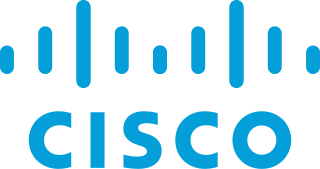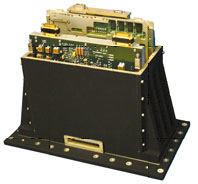Related Research Articles

Ethernet is a family of wired computer networking technologies commonly used in local area networks (LAN), metropolitan area networks (MAN) and wide area networks (WAN). It was commercially introduced in 1980 and first standardized in 1983 as IEEE 802.3. Ethernet has since been refined to support higher bit rates, a greater number of nodes, and longer link distances, but retains much backward compatibility. Over time, Ethernet has largely replaced competing wired LAN technologies such as Token Ring, FDDI and ARCNET.

A local area network (LAN) is a computer network that interconnects computers within a limited area such as a residence, school, laboratory, university campus or office building. By contrast, a wide area network (WAN) not only covers a larger geographic distance, but also generally involves leased telecommunication circuits.
Latency, from a general point of view, is a time delay between the cause and the effect of some physical change in the system being observed. Lag, as it is known in gaming circles, refers to the latency between the input to a simulation and the visual or auditory response, often occurring because of network delay in online games.

A router is a computer and networking device that forwards data packets between computer networks, including internetworks such as the global Internet.

A wide area network (WAN) is a telecommunications network that extends over a large geographic area. Wide area networks are often established with leased telecommunication circuits.
A network switch is networking hardware that connects devices on a computer network by using packet switching to receive and forward data to the destination device.

A metropolitan area network (MAN) is a computer network that interconnects users with computer resources in a geographic region of the size of a metropolitan area. The term MAN is applied to the interconnection of local area networks (LANs) in a city into a single larger network which may then also offer efficient connection to a wide area network. The term is also used to describe the interconnection of several LANs in a metropolitan area through the use of point-to-point connections between them.

Cisco Systems, Inc.,, is an American multinational digital communications technology conglomerate corporation headquartered in San Jose, California. Cisco develops, manufactures, and sells networking hardware, software, telecommunications equipment and other high-technology services and products. Cisco specializes in specific tech markets, such as the Internet of things (IoT), domain security, videoconferencing, and energy management with leading products including Webex, OpenDNS, Jabber, Duo Security, Silicon One, and Jasper.

Internet access is a facility or service that provides connectivity for a computer, a computer network, or other network device to the Internet, and for individuals or organizations to access or use applications such as email and the World Wide Web. Internet access is offered for sale by an international hierarchy of Internet service providers (ISPs) using various networking technologies. At the retail level, many organizations, including municipal entities, also provide cost-free access to the general public.
Local Area Transport (LAT) is a non-routable networking technology developed by Digital Equipment Corporation to provide connection between the DECserver terminal servers and Digital's VAX and Alpha and MIPS host computers via Ethernet, giving communication between those hosts and serial devices such as video terminals and printers. The protocol itself was designed in such a manner as to maximize packet efficiency over Ethernet by bundling multiple characters from multiple ports into a single packet for Ethernet transport.
Sandy Lerner is an American businesswoman and philanthropist. She co-founded Cisco Systems, and used the money from its sale to pursue interests in animal welfare and women's writing. One of her main projects, Chawton House, is in England, but most of her work remains in the United States.

William "Bill" Yeager is an American engineer. He is an inventor of a packet-switched, "Ships in the Night", multiple-protocol router in 1981.

A computer network is a set of computers sharing resources located on or provided by network nodes. Computers use common communication protocols over digital interconnections to communicate with each other. These interconnections are made up of telecommunication network technologies based on physically wired, optical, and wireless radio-frequency methods that may be arranged in a variety of network topologies.
In capital markets, low latency is the use of algorithmic trading to react to market events faster than the competition to increase profitability of trades. For example, when executing arbitrage strategies the opportunity to "arb" the market may only present itself for a few milliseconds before parity is achieved. To demonstrate the value that clients put on latency, in 2007 a large global investment bank has stated that every millisecond lost results in $100m per annum in lost opportunity.
The Stanford University Network, also known as SUN, SUNet or SU-Net is the campus computer network for Stanford University.

Internet Routing in Space (IRIS) was a program to build a radiation-tolerant IP router created by Cisco Systems for satellite and related spacecraft. It was a follow-on from Cisco's earlier CLEO router in space on the UK-DMC satellite. The Cisco Space Router was launched to geostationary orbit on board Intelsat 14 (IS-14), a spacecraft built by Space Systems/Loral for satellite operator Intelsat, in November 2009. IRIS was evaluated by the United States Department of Defense by way of a JCTD. The Space Router runs Cisco IOS software and also contains an onboard Software-defined radio running satellite modem waveforms. The United States Department of Defense used the JCTD to evaluate the reduced latency, improved throughput and increased flexibility provided by the Space Router.
The Computer Entrepreneur Award was created in 1982 by the IEEE Computer Society, for individuals with major technical or entrepreneurial contributions to the computer industry. The work must be public, and the award is not given until fifteen years after the developments. The physical award is a chalice from sterling silver and under the cup a gold-plated crown.

XKL, LLC is an American company that develops optical transport networking technologies. Founded in 1991 and based in Redmond, Washington, XKL is led by Cisco Systems co-founder Len Bosack.
Ashwin Gumaste is an Indian computer engineer and institute chair professor at the department of computer science and engineering of the Indian Institute of Technology, Bombay. He is known for his work on Carrier Ethernet Switch routers—the largest technology transfer between any IIT and industry.
References
- 1 2 "Computer Entrepreneur Award" Archived December 30, 2010, at the Wayback Machine . IEEE Computer Society. Accessed December 30, 2010.
- 1 2 3 4 5 "Len Bosack 2009 Computer Entrepreneur Award Recipient". IEEE Computer Society. Accessed December 30, 2010.
- ↑ "About" Archived October 25, 2010, at the Wayback Machine . XKL LLC. Accessed December 30, 2010.
- 1 2 3 4 5 "Does Pink Make you Puke?". Forbes . Accessed December 30, 2010.
- 1 2 3 "Adult Supervision". Nerds 2.0.1: A Brief History of the Internet . Public Broadcasting Service (PBS). Accessed December 30, 2010.
- ↑ "Router man". Networkworld.com. March 27, 2006. Archived from the original on April 5, 2006. Retrieved November 2, 2012.
- ↑ Pete Carey (January 12, 2001). "A start-up's true tale". Mercury News .
- ↑ "Calculated as 1 / (speed of light / 1231 km)" . Retrieved March 3, 2016.
- ↑ "Center for Conservation Biology". University of Washington. Accessed December 30, 2010.
- ↑ Pete Carey (December 1, 2001). "A start-up's true tale". Mercury News . Accessed December 30, 2010.